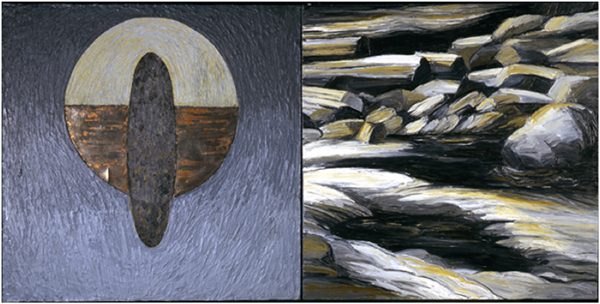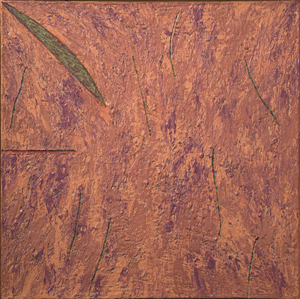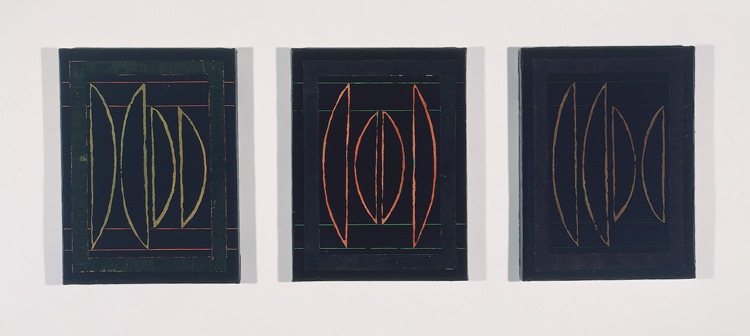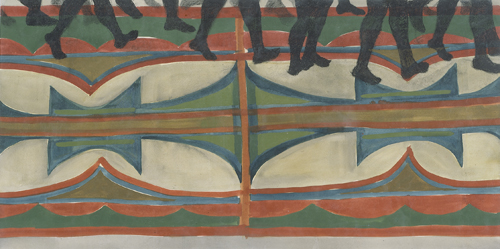Art Review: Kay WalkingStick at the Montclair Art Museum
By Christina Turczyn
arttimesjournal March 7, 2018
Where are the Generations?
Where are the generations, the unborn trees in bodies of war?
 Kay WalkingStick Night, 1991 Oil, acrylic, wax, and copper on canvas Montclair Art Museum, purchased with funds provided by Alberta Stout. Courtesy of the artist. |
When I look at Kay WalkingStick's Farewell to the Smokies (2007) in which haunting, barely outlined figures walk away from their land during the Trail of Tears, I think of her powerful, genre-breaking work in a political light, about the ways in which works such as Where are the Generations (1991), or Who Stole My Sky (1971) challenge the viewer to enter a world that has been driven from landscape, as words may be loosed from their histories, set adrift from meanings by the violence of neglect. In the latter painting, stacked canvas leads to a cobalt focal point. Like words, clouds disappear as they eye travels to the center of the work.
In some ways, the artist’s internationally recognized diptychs call attention to dichotomies of landscape: On one visual plane, a representational vista depicts a place that might exist and is refracted through the artists’ perception. On the other, an abstract field, as WalkingStick states, is “in dialogue” with the complementary painting. Each panel informs the other, while neither view of the world is privileged. I am reminded of the invisible line between moving water and sky.
I am reminded, also, of how culture and history form a specific topography. People inhabit a place that recalls both their presence and erasure. Words become geography, and then languages are forgotten. The artist created a number of paintings with her hands—they are at once sensual and contemplative.
The tension between figuration and abstraction in this exhibit is brought to the fore through the chronological organization, as well as in works such as Late Summer on the Ramapo (1987-1991) and Eden, Perceptual Dilemma (1985-1987) Both works are created with wax on canvas, with translucent layers. The dilemma might be one that seeks a tranquil place in a landscape of loss. Yet does it exist, and how would one define it? Myth is in conversation with representation, so that myth never becomes a monolithic story, yet listens to the other voice. Poet Joy Harjo, writing in her collection of essays, The Spiral of Memory, offers insights about myth that resonate with WalkingStick’s work: “Perhaps humans are being rewritten by myth. The dynamic relationship is everywhere. The rain clouds respond to us, and we respond to them. Many cultures have nurtured this relationship. It’s like any other thing that’s nourished and taken care of, the relationship flourishes.”
The artist mentions that her diptychs offer two ways of looking at the world, with neither taking precedence over the other. Like clouds on a lake, images shimmer on both panels, never offering an exact reflection. How can one separate language from the earth?
Kay WalkingStick: An American Artist
 Kay WalkingStick Montauk II (Dusk), 1983 Acrylic, wax, and ink on canvas 56 x 56 x 4.25 in. Collection of the artist Photo: Lee Stalsworth, Fine Art through Photography, LLC Courtesy American Federation of Arts |
The exhibit, on its final destination of a national tour, is organized by the American Federation of Arts with the Smithsonian’s National Museum of the American Indian curator Kathleen Ash-Milby, associate director David W. Penney, and Gail Stavistky, chief curator at the Montclair Art Museum. Housed at the Montclair Art Museum, the work will be available to the public from February 3, 2017 to June 17, 2018. The exhibit includes over 60 of WalkingStick’s works—paintings and notebooks, as well as drawings. The artist, a dual citizen of both the Cherokee Nation and the United States, was born in Syracuse, New York in 1935. According to David Penney, Kay WalkingStick was “excluded from the discourse of contemporary art,” yet “remains an iconic artist who has changed the field.” Her honors include representation in the Smithsonian’s National Museum of the American Indian, the National Gallery of Canada, the Metropolitan Museum of Art, and the Montclair Museum of Art, among other institutions. The exhibit spans depictions of “the sensual body,” in which WalkingStick’s bold palette creates portraits of her husband and herself to “the heroic landscape,” which features paintings from 2012 to the present. Though aware of, as well as involved in the minimalist movements that coincided with her early pieces, the artist has often commented upon her work as arising from her own vision and sensibility. “I think artmaking is a visual record of our experience on earth,” she observes, and her singular style, often juxtaposing Navajo textile design with Southwestern landscape, works against violence--through change. If the viewer stands directly in front of Farewell to the Smokies (2007), the mountains assume a cavernous, demanding presence. If I walk away from the painting, a line of people at its base become the painting’s most harrowing feature. History is burning, as families continue to walk.
 Kay WalkingStick Chief Joseph Series 1974–76 Acrylic, ink, and wax on canvas 20 x 15 in. each. (27 panels of a 36-panel series) National Museum of the American Indian Courtesy American Federation of Arts |
The same is true of Where Are the Generations (1991.) At the center of the painting is an ochre circle, surrounded by a deep, sapphire field. Initially, the text, hardly visible, seems inscrutable. The text emerging gradually in the foreground is: “In 1492, we were twenty million. Now, we are two million. Where are the generations, never born?” From a distance, the sphere becomes more prominent--a universe, suggesting that viewers would need the perspective of time and distance to understand the weight of genocide.
At the same time, death is rarely perceived by the artist as empty. I was immediately struck by the Chief Joseph Series (1974-1976). Originally composed of 36 panels, the series of paintings, according to the artist’s description, asks viewers to walk around the work, because of its sculptural nature, emotional impact. WalkingStick’s perspectives about art and life become apparent in the contrasts that arise between the brilliant red and black squares, and others that recede in silence. Although one of the squares is dense, as well as almost entirely black—the paintings express gravity, rather than emptiness. Some have compared this piece to an elegy. The repeated shapes, which appear in other paintings, translate silence. The base of the piece casts shadows onto the wall, while blank rows between the paintings allow for interpretation. “From where the sun now stands,” Chief Joseph declared in his surrender speech of 1877, “I will fight no more, forever.” “I want to look for my children,” he added. “and see how many of them I can find.”
I have always been fascinated by blank spaces, which serve as canvases when words fail. What else might account for the resonance and impact of graphic fiction, especially fiction that attempts to approach the experience of trauma and dislocation? If history were presented in fine detail, viewers could hardly bring their own memories to the work. Past trauma requires telling the story on a page without tense.
 Kay WalkingStick Over Lolo Pass, 2003 Charcoal, gouache, and encaustic on paper 25X50 inches Collection of the Artist |
Throughout the exhibit, there is a sense of movement and transformation. A waterfall series, created while the artist was mourning her husband’s sudden death, includes a piece titled Letting Go from Chaos to Calm (1990). Waterfalls, as Kathleen Ash-Milby reminds us, signal the passage of time. I was especially moved by the silent power of Howitzer Hill Fusillade (2008), in which a river of fire recalls Chief Joseph being attacked. Yet we are looking at history through brilliant orange diamonds—unbroken, rooted in earth, and clear.
The work is always regenerative, defying categorization. A poem by J. Nelson, commissioned in 1969, does not sum up, but opens up, perspectives on Kay WalkingStick’s power:
If you can only groove on conflict,
You’ll miss the gentle paradoxes she explores,
contentment in desire, energy in repose, conquest in surrender.
How has she revealed and transformed these elements into her unique vision?
Perhaps because Kay is part Cherokee, a proud, peace-loving people,
at home in their bodies, and secure in the real world of nature…
More likely it’s because she is that unique creator and creation—
a woman, giving by accepting.
Works Consulted
Harjo. Joy. The Spiral of Memory. University of Michigan Press, 1996.
Vantage Point. Chief Joseph Series. Smithsonian National Museum of the American Indian, 2011.
